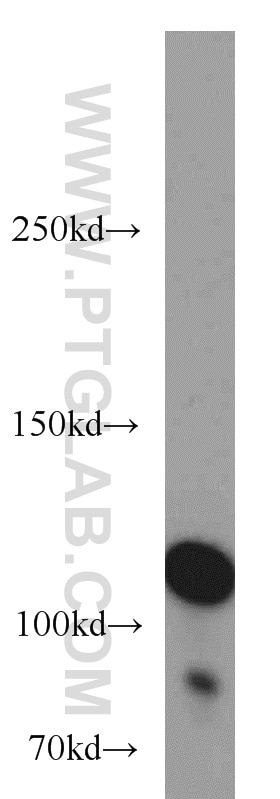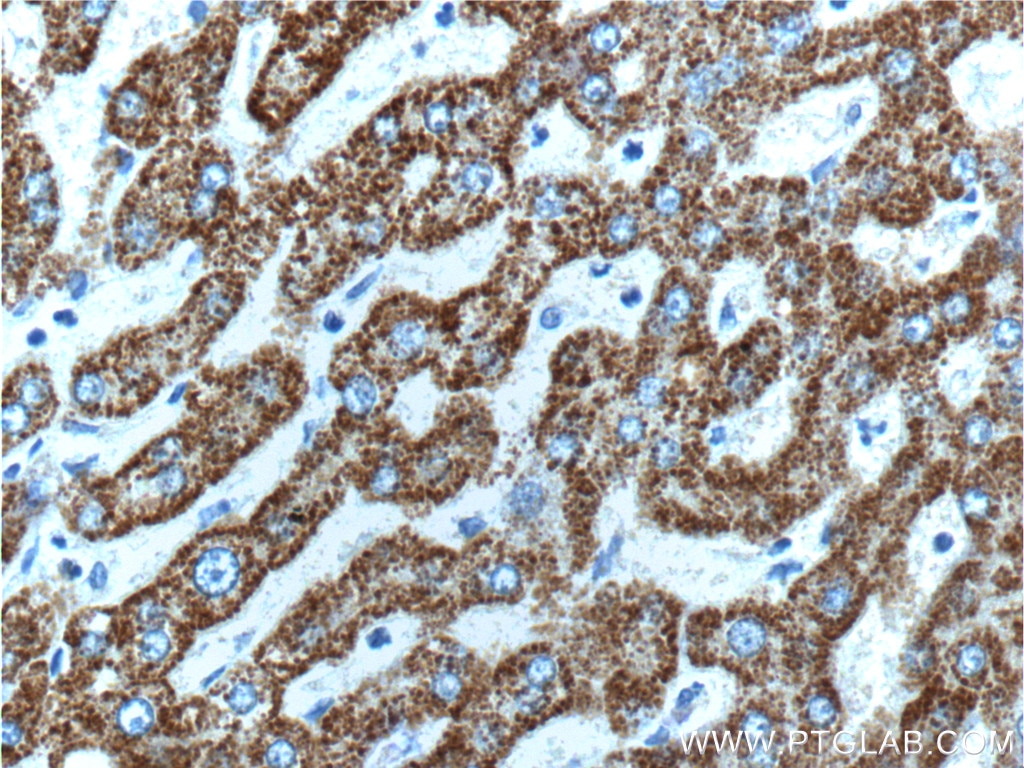Tested Applications
| Positive WB detected in | HeLa cells, K-562 cells, mouse brain tissue, rat brain tissue |
| Positive IP detected in | mouse brain tissue |
| Positive IHC detected in | human liver tissue, mouse brain tissue Note: suggested antigen retrieval with TE buffer pH 9.0; (*) Alternatively, antigen retrieval may be performed with citrate buffer pH 6.0 |
| Positive IF/ICC detected in | HeLa cells |
Recommended dilution
| Application | Dilution |
|---|---|
| Western Blot (WB) | WB : 1:5000-1:50000 |
| Immunoprecipitation (IP) | IP : 0.5-4.0 ug for 1.0-3.0 mg of total protein lysate |
| Immunohistochemistry (IHC) | IHC : 1:50-1:500 |
| Immunofluorescence (IF)/ICC | IF/ICC : 1:200-1:800 |
| It is recommended that this reagent should be titrated in each testing system to obtain optimal results. | |
| Sample-dependent, Check data in validation data gallery. | |
Published Applications
| KD/KO | See 1 publications below |
| WB | See 10 publications below |
| IHC | See 1 publications below |
| IF | See 6 publications below |
Product Information
10390-1-AP targets HGS in WB, IHC, IF/ICC, IP, ELISA applications and shows reactivity with human, mouse, rat samples.
| Tested Reactivity | human, mouse, rat |
| Cited Reactivity | human, mouse |
| Host / Isotype | Rabbit / IgG |
| Class | Polyclonal |
| Type | Antibody |
| Immunogen |
CatNo: Ag0589 Product name: Recombinant human HGS protein Source: e coli.-derived, PGEX-4T Tag: GST Domain: 186-387 aa of BC003565 Sequence: GQIFCGKCSSKYSTIPKFGIEKEVRVCEPCYEQLNRKAEGKATSTTELPPEYLTSPLSQQSQLPPKRDETALQEEEELQLALALSQSEAEEKERLRQKSTYTSYPKAEPMPSASSAPPASSLYSSPVNSSAPLAEDIDPELARYLNRNYWEKKQEEARKSPTPSAPVPLTEPAAQPGEGHAAPTNVVENPLPETDSQPIPPS Predict reactive species |
| Full Name | hepatocyte growth factor-regulated tyrosine kinase substrate |
| Calculated Molecular Weight | 86 kDa |
| Observed Molecular Weight | 110 kDa |
| GenBank Accession Number | BC003565 |
| Gene Symbol | HGS |
| Gene ID (NCBI) | 9146 |
| RRID | AB_2118914 |
| Conjugate | Unconjugated |
| Form | Liquid |
| Purification Method | Antigen affinity purification |
| UNIPROT ID | O14964 |
| Storage Buffer | PBS with 0.02% sodium azide and 50% glycerol, pH 7.3. |
| Storage Conditions | Store at -20°C. Stable for one year after shipment. Aliquoting is unnecessary for -20oC storage. 20ul sizes contain 0.1% BSA. |
Background Information
Hepatocyte growth factor-regulated tyrosine kinase substrate (HGS, synonyms: HRS, ZFYVE8) is a 110 to 115-kDa zinc finger phosphotyrosine protein inducible by stimulation with interleukin 2 (IL-2), granulocyte-macrophage colony-stimulating factor (GM-CSF) as well as hepatocyte growth factor (HGF), and is associated with signal-transducing adaptor molecule (STAM). HGS suppresses DNA synthesis upon stimulation with IL-2 and GM-CSF, counteracting STAM's function, which is critical for cell growth signaling mediated by the cytokines. HGS also interacts with the neurofibromatosis 2 tumor suppressor protein Schwannomin/merlin. The growth suppression activity of schwannoma/merlin requires HGS. The binding of schwannoma/merlin to HGS facilitates its ability to function as a tumor suppressor, probably by inhibiting STAT activation.
Protocols
| Product Specific Protocols | |
|---|---|
| IF protocol for HGS antibody 10390-1-AP | Download protocol |
| IHC protocol for HGS antibody 10390-1-AP | Download protocol |
| IP protocol for HGS antibody 10390-1-AP | Download protocol |
| WB protocol for HGS antibody 10390-1-AP | Download protocol |
| Standard Protocols | |
|---|---|
| Click here to view our Standard Protocols |
Publications
| Species | Application | Title |
|---|---|---|
EMBO Rep The USP12/46 deubiquitinases protect integrins from ESCRT-mediated lysosomal degradation | ||
Sci Rep β-defensin 1 expression in HCV infected liver/liver cancer: an important role in protecting HCV progression and liver cancer development. | ||
Mol Biol Cell The ubiquitin ligase Deltex-3L regulates endosomal sorting of the G protein-coupled receptor CXCR4. | ||
J Cell Sci Neutral sphingomyelinase 2 controls exosome secretion by counteracting V-ATPase-mediated endosome acidification. | ||
J Virol Human Cytomegalovirus Hijacks WD Repeat Domain 11 for Virion Assembly Compartment Formation and Virion Morphogenesis. |
Reviews
The reviews below have been submitted by verified Proteintech customers who received an incentive for providing their feedback.
FH Wojciech (Verified Customer) (09-10-2025) | Tested HG5 antibody in T-cells and it consistently detected the expected 100 kDa band with strong specificity and very low background. Results were reproducible across experiments, and overall performance was good.
|






















